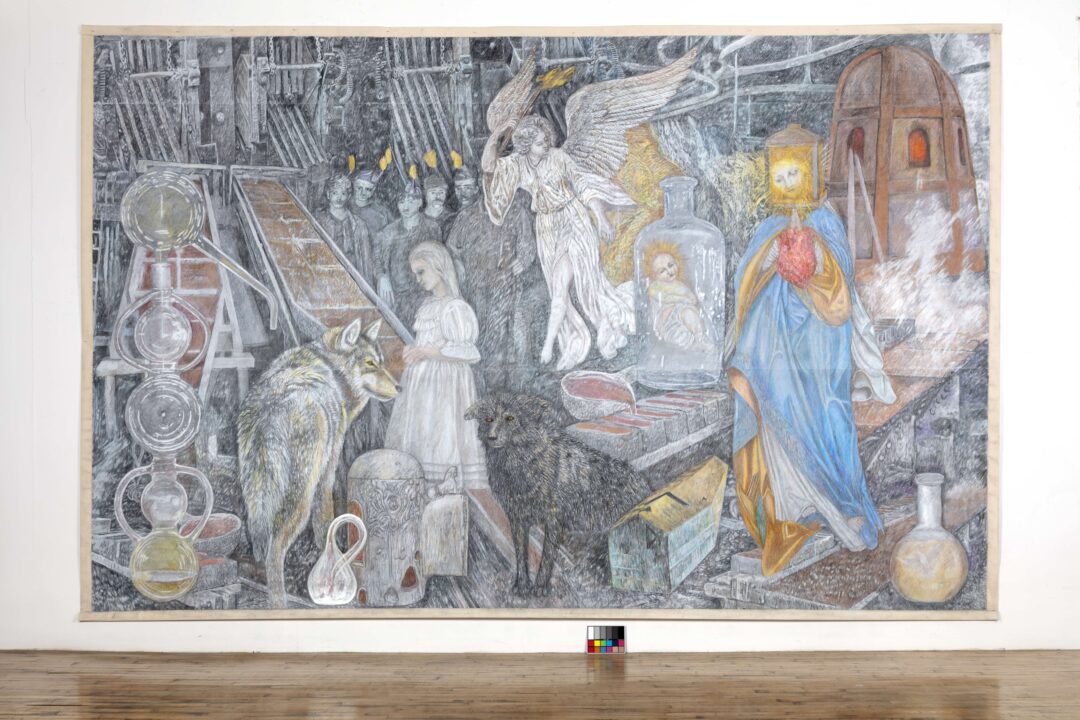Guggenheim Foundation Project 2019-2022
How childhood dreams and experiences can suggest an unconscious theme and determine the later developments in the psyche has always been an interest of mine. My childhood experiences have fueled my art, and have presented keys to later life developments. During my childhood, my father owned mines in Colorado, and a share in a mill complex called The Wolf Tongue Mill, in Nederland Colorado. My father was a scientist who produced a tungsten byproduct called Scheelite, used for the nose cones of rockets and lighting. Tungsten was the last ore refined in that mill.
The area around Nederland Colorado and Central City Colorado saw several waves of mining from the 1860’s on. The first was a gold rush, followed by a silver boom, and later tungsten mining. As a child I visited the mines with my father.I also spent hours in the Wolf Tongue Mill, a huge cavernous structure that covered a side of a mountain, with tailings ponds below. The mines were for me a metaphor for the unconscious realm below the surface. Often, dreams about entering the unconscious can take the form of elevators, caves, and shafts. The chthonian realm is the unconscious realm. For both children and adults, the unconscious is a place or transformation, but can also be a place of terror. At eight years of age, I saw my father carry a dead miner from a horizontal shaft after a cave in. The mines became entrances into the psyche, taking on a mythical quality.
Both at the mill, and on the site of the mines, were small assay offices for the assessment of the ore. My earliest childhood dream was of a king being ground up using a mortar and pestle. I saw this dream forty years later in an alchemical book on Zosimos of Panopolis, a third century Alexandrian alchemist. My father’s laboratory and the assay offices with their glassware became associated with alchemical laboratories and transformation processes. On Saturdays, I cleaned my father glassware. The mines became a symbol of the unconscious, the mill a metaphor for refining the contents of the unconscious, and the assay offices became associated with alchemists.
Several artists who have worked with the subject of mines also interested me. William Kentridge made a film called “Mine” in 1991. Kentridge’s journey into the mines provides a visual representation of a journey into the conscience of Kentridge’s invented character, Soho Eckstein, the white South African property owner who exploits the resources of land and black
miners who are under his domain. Another artist Bill Morrison made a film called “The Miners Hymns” using old footage to describe life in the coalmines of North East England. My interest in the mines also has a historical and political element. Many of the early Colorado miners, like my relatives, came from Ireland. Central City had an Ancient Order of the Hibernians, to support the Irish who were persecuted for their ethnicity and Catholic faith. The stories of the miners and the Chinese working in the shafts were like fairy tales. The world of the Irish terriers came to life in the stories old miners would tell me. I later found the writing of Michael Mac Gowan, a miner who wrote in the Irish language, about his experiences in the Klondike. I wanted to weave his narrative into a pictorial story of the mill.
The Wolf Tongue Mill was a structure a city block long made of terraced buildings on a hillside. The interior was filled with long troughs, conveyor belts, and tables. Ore would be crushed and tumbled and passed along with a system of belts with wheels. The dark interior looked like a Piranesi fantasy architectural drawing. I began to see the ore as an alchemical parable of transformation, paralleling developments in the psyche. Alchemy involves the transmutation of the ores from lead into gold. As a child I imagined a real wolf was living in the mill. The wolf in alchemy is a symbol of the prima materia. Miners are also shown in alchemical texts like “The Splendor Solis,” because mining is a symbol of the alchemical process.
